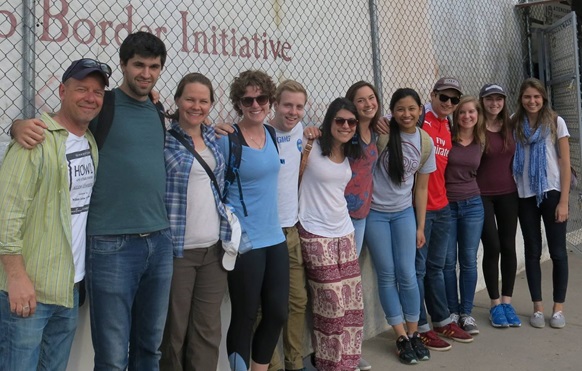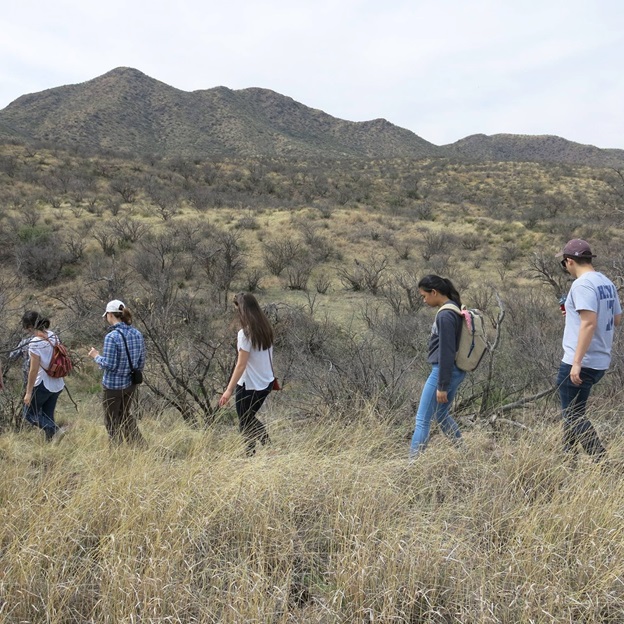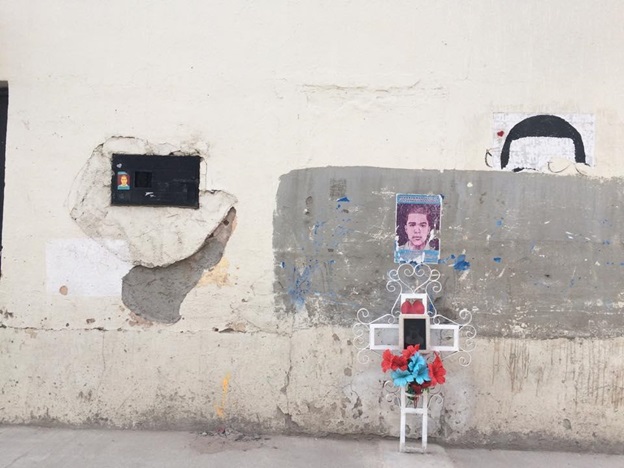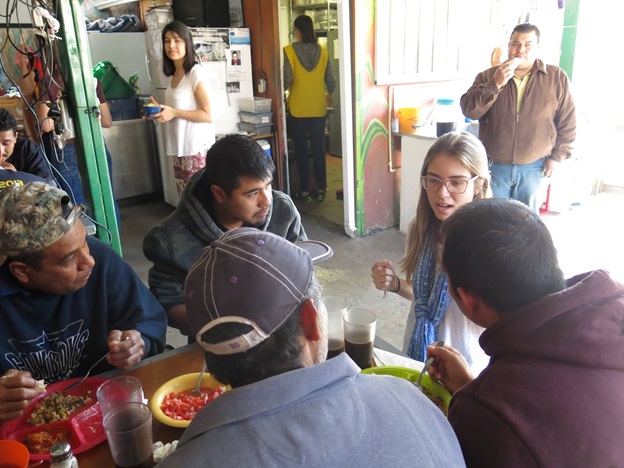Author: Sofia Vargas
 Photo: Grace Laria Photo: Grace Laria |
On March 5th, 2016, I embarked on a week-long immersion trip with ten other Georgetown students, Jesuit priest Fr. Gregory Schenden, and Georgetown Center for Social Justice staff member Lauren Johannesson-McCoy to Arizona for an annual Alternative Spring Break trip to the U.S. southern border. In Tucson and its surrounding areas, which are at the crux of the national debate over immigration, my cohort and I explored the multi-faceted complexities of immigration in the United States through immersion and Ignatian reflection. Our goal throughout the week was to humanize the border experience so that we could come back to D.C. with a better understanding of what’s at stake in the political debate over immigration and border issues.
During the trip we observed an Operation Streamline hearing, visited Tucson’s Customs and Border Patrol (CBP) headquarters, received a tour of Eloy Detention Center, and visited the Kino Border Initiative in Nogales, Sonora. We spoke with an attorney at the Florence Immigrant and Refugee Rights Project, ranchers from the southern town of Arivaca, federal public defenders, a judge at the District Court of Arizona, and local faith leaders and activists.
Arivaca: Migrant Trails and Ranches
 Photo: Grace Laria Photo: Grace Laria |
We began our week in Arivaca near the border, where Fr. Peter Neeley of the Kino Border Initiative led us down a commonly traversed migrant path to witness some of the dangers of the desert that migrants face when attempting to cross the border. Running through thorny bushes and over deep ditches is inevitable when crossing the desert, yet these physical dangers are exacerbated because migrants travel mostly at night to decrease their chance of getting caught by Border Patrol agents. Year-round, migrants face extreme thirst and hunger, and in the rainy monsoon seasons, the non-absorbent desert is the site of dangerous floods that cause many migrants to drown each year. Additionally, women are sexually assaulted, people are injured, and traffickers high on drugs leave behind many migrants along the way to the border. The Colibri Center, a nonprofit advocacy organization based in Tucson, estimates that in Arizona alone, at least 2,202 migrants lost their lives while crossing the U.S.-Mexico border between 2001 and 2013. The number of deaths fluctuates each year depending on overall migration flows and border enforcement, but it is still evident that the number of migrant deaths in the desert is too high.
That same day, we spoke with local ranchers in Arivaca who fear the trespassing of migrants and of drug traffickers on their land. They emphasized that the narcotics demand in the United States is causing violence and a lack of safety at the border. They advocate for a more secure border, while praising Border Patrol agents for doing their jobs to protect. Although I sympathized more with the migrants, especially after having seen the dangerous terrain they are forced to pass through, it was helpful to see that border residents have valid reasons to advocate for a safer and more secure border, while recognizing that American demand for drugs perpetuates much violence on both sides of the border. As I learned throughout the whole week, immigration is a multi-faceted and complex issue that requires all sides to voice their opinions in respectful dialogue.
An Afternoon in Eloy
A few days later, we drove from Tucson to Eloy Detention Center, a Corrections Corporation of America (CCA) facility, for a guided tour led by two Immigration and Customs Enforcement (ICE) compliance officers. During our question and answer session, I asked about the recent media attention Eloy has been getting about its lack of medical care available for detainees. This past summer, a detainee committed suicide while in custody at Eloy. This was the fifth suicide to occur in this detention center since 2003, making Eloy the immigration detention center with the highest suicide rate in the nation. In response, the compliance officer simply told me that CCA and ICE take detention deaths very seriously, and that Eloy has some of the best medical care in detention in the country. Yet, his assertion was challenged by the 200 detainees who staged a hunger strike last June and who claimed that someone else had died at Eloy unannounced. Evidently, these events indicate that Eloy as well as other detention centers need to be more transparent. In their efforts to dispel the negative press about the recent deaths and complaints, CCA opened up the facility to press visits ten weeks after the June suicide, and my group and I were able to take advantage of a tour during our time in Arizona to see the conditions under which detainees live at Eloy.
Eloy holds over 1,500 beds and should have extensive medical and mental health services available to serve such a large population, especially since migrants face traumatizing experiences before, during, and after their journeys. The fact that Eloy has the highest number of deaths in detention of any facility in the nation raises concerns that cannot be erased by simple verbal reassurance from ICE compliance officers. The lack of transparency is obvious while touring the facility, and hopefully future Kino Border Immersion trips will be able to visit Eloy detainees and listen to their stories. Only then can people really see what kind of treatment detainees receive at the CCA facility.
Operation Streamline and Its Discontents
The next day, we attended an Operation Streamline hearing at the Ninth Circuit Court of Tucson where, in under an hour, we witnessed over 60 people being sentenced to jail time for having illegally entered the United States, most through Nogales. Operation Streamline began in 2005 as an initiative of the Department of Homeland Security and the Department of Justice under which undocumented migrants can face criminal prosecution and deportation as a result of illegal entry or re-entry into the United States. Operation Streamline has been heavily criticized over the years, and it is a process that many advocates and lawyers, even judges, resent having to work through.
The men and women being prosecuted were all in handcuffs and shackles during the entirety of the hearing, and they were called up in groups of about seven people at a time to plead their cases. The detainees spoke Spanish, and most of the attorneys present were defending multiple people at a time. According to Judge Jacqueline Rateau, presiding at the hearing that day, attorneys only get about half an hour in the morning to explain the cases to their clients so that they can plead their cases in the afternoon. Amanda Sakuma of MSNBC describes immigration proceedings under Operation Streamline as “[running] more like a conveyor belt than a courtroom.” The mere nature of these proceedings calls into question whether or not migrants are getting the due process they deserve under the Fifth Amendment of the Constitution. But unfortunately, Arizona courts are so backlogged on immigration cases that even though Operation Streamline is ineffective and undermining civil rights and due process, there is very little that can come in the short term to improve the legal system with respect to immigration proceedings.
Ambos Nogales
 Photo: Sofia Vargas Photo: Sofia Vargas |
My cohort and I ended our trip with a visit to Nogales, Sonora on Friday, March 11th. There we met with Joanna Williams, a Georgetown Alum and staff member at the Kino Border Initiative (KBI). She showed us around the city, emphasizing the fact that Nogales, Arizona and Nogales, Sonora, colloquially known as “Ambos Nogales” (Both Nogales), used to be more physically and socially unified before the border became more secured. Joanna also took us to the site where 16-year-old Nogales resident José Antonio Elena Rodriguez was shot and killed in 2012 by Border Patrol agents from the other side of the border fence. This emblematic case is a constant reminder for the people of Nogales of just how brutally la migra, or Border Patrol, has acted, and almost always in impunity. José Antonio’s life and death serves as a testimony in the darkest sense to how U.S. immigration enforcement affects people on both sides of the border.
That day we served breakfast and lunch at the KBI comedor (soup kitchen), and we were fortunate enough to speak with migrants at both the comedor and at KBI’s women’s migrant shelter. The staff at the comedor are mostly volunteers, who start off each meal with a quick game or song to lighten the mood and to make migrants feel at home. The Georgetown group and I spoke to people before and after meals to hear their stories. Many of the deportees had children and other family members who were U.S. citizens. Many, if not most, of the migrants and deportees were not even from the Nogales area. In fact, all of the people I spoke with were from western or southern Mexico, either from the states of Guerrero, Puebla, or Chiapas, some of the most dangerous states in the country. The southwestern state of Guerrero has recently been named Mexico’s most violent state and Acapulco was named the world’s third most violent city due to the violence caused by the Sinaloa cartel. The Sinaloa cartel also operates heavily in Nogales, and the presence of cartel members in Nogales is a threat to migrants in transit. The situation is so precarious that migrants are warned by locals to stay indoors at night and from straying away from the area around the comedor in order to avoid getting kidnapped and trafficked or forced to work for the cartel.
Most of the people eating at the comedor were men, ranging from about nineteen to sixty-five years old, with the addition of about five or six women and one thirteen-year-old girl who were eating there that day. One man who had been deported back to Mexico that morning complained to the KBI staff about an incident that had occurred that day when he was released in Nogales, Sonora. He mentioned that CBP had released a man from custody to his family, but the agents had left his handcuffs on, with a broken chain, but with the cuffs still on his wrists. This was a clear violation of the deportee’s rights, and KBI staff said they would follow up on this by submitting a complaint to CBP. Unfortunately, however, this case is one of many, and migrants are often reluctant to register complaints, because they do not think it will make a difference, are afraid of retaliation, or more likely are unaware that they can. A 2014 report by the American Immigration Council shows that the majority of complaints, over 58% in fact, have resulted in no action being taken by the agency to investigate. In its 2015 report, KBI included in its recommendations that “CBP must ensure an open, accessible, transparent, accountable, and responsive complaint process.”
 Photo: Grace Laria Photo: Grace Laria |
Perhaps the most striking encounter I had that day was with a trio of young men who had most likely been turned away at the border just moments before they showed up at the comedor since they lacked the government-issued plastic bags for their belongings that other deportees had. One of the boys was only fourteen years old, and his twenty-year-old brother, Fernando* spoke to me as well as his nineteen-year-old friend, Emilio*, who had journeyed with them. The three boys were coming from a village in Guerrero, and I was asked by staff to assist them in filling out their intake forms for KBI. The two brothers were sick with a cold, and luckily Fernando had been able to get medicine at a pharmacy before arriving for lunch. Both Fernando and Emilio had trouble reading, the youngest boy apparently couldn’t read or write at all, and it was evident that Spanish was Emilio’s second language because Fernando would translate some of the instructions they were being given by staff into their native indigenous language. They were trying to get to the United States to find jobs and to be with family that had made it across, they said. However, since they were traveling from the most violent state in Mexico, I am sure there is more to their story and motives for leaving Mexico than what I was able to gather from this short conversation.
The most heartbreaking of it all was the fact that CBP turned away a minor without a proper screening process or the chance to be relocated with family living in the United States. According to a federal audit cited by The Guardian, from 2009 to 2014, CBP “repatriated 93% of unaccompanied children under age 14 from Mexico and Canada without documenting how they decided that the children would be safe when they return to their home countries.” Fernando’s younger brother was not unaccompanied, since he was clearly travelling with two young men, however, this case is an example of how current CBP screening processes lead to the violation of rights of children and asylum seekers upon arriving at the border. With further screening, it is possible that this fourteen year old boy could have had grounds for asylum or protection, but instead, he was turned away upon arriving in Nogales, with little chances of him and his travel companions to seek the help they need to leave their violent home state.
Back Home in D.C.
Our overall experience as students during this trip was shaped by the stories we heard, the paths we walked, and the reflections we had each day. The emotional, physical, and mental obstacles that migrants face had never felt so real to us, and a common feeling we experienced was the frustration of having been in D.C. for so long without knowing what life is like at the border. We observed how easy it is to get caught in a bubble of notions, ideas, and policies that seem to explain the state of immigration at the border region without being sure that these ideas and policies actually work. As our policymakers work to address our broken immigration system from the halls of Washington, D.C., we would strongly encourage them to make a similar visit, talk with various stakeholders, and experience the reality of the border for themselves.
*Name has been changed for confidentiality reasons.

